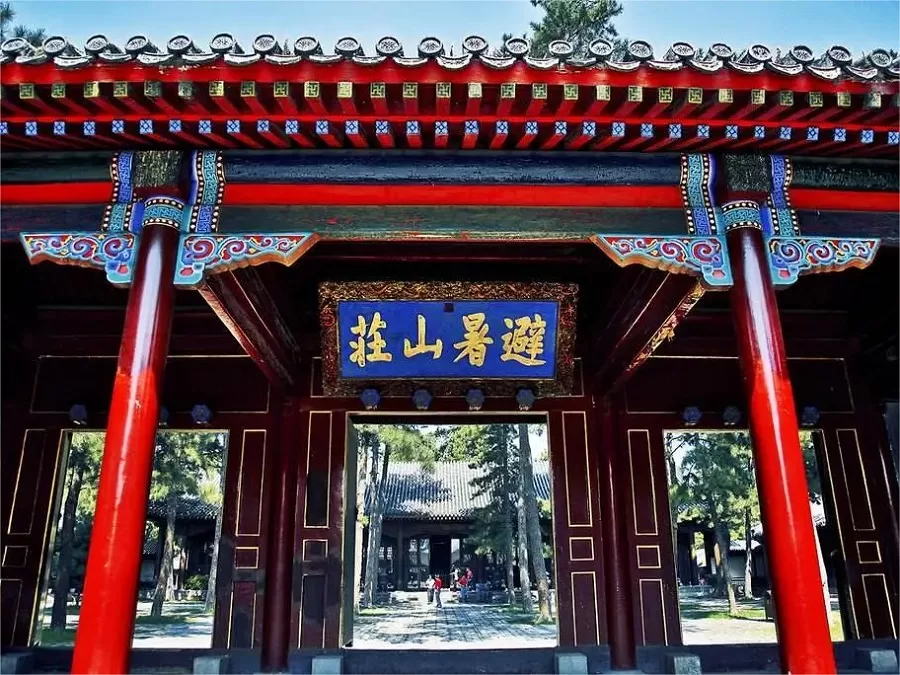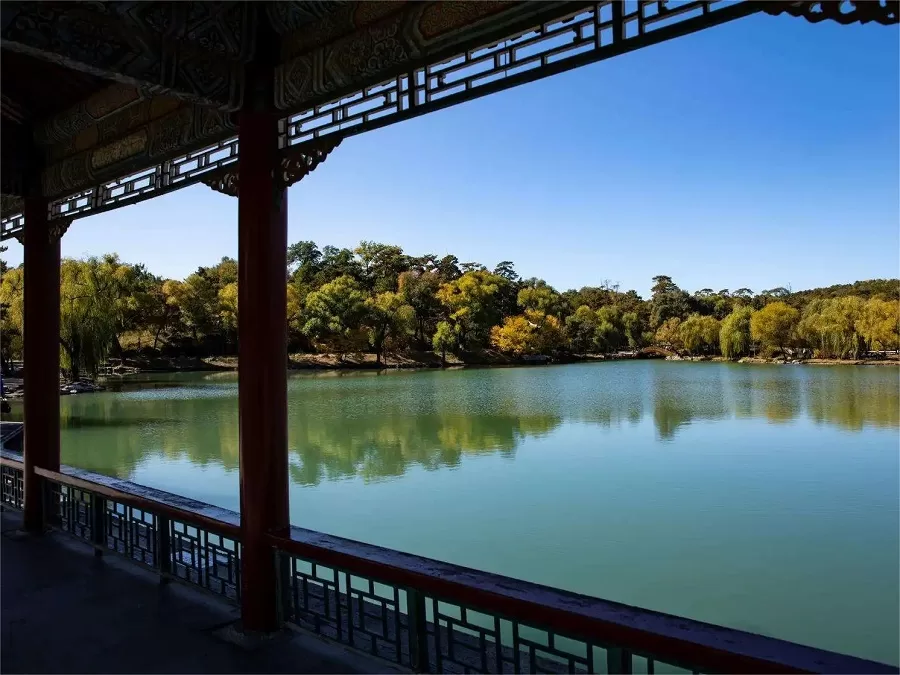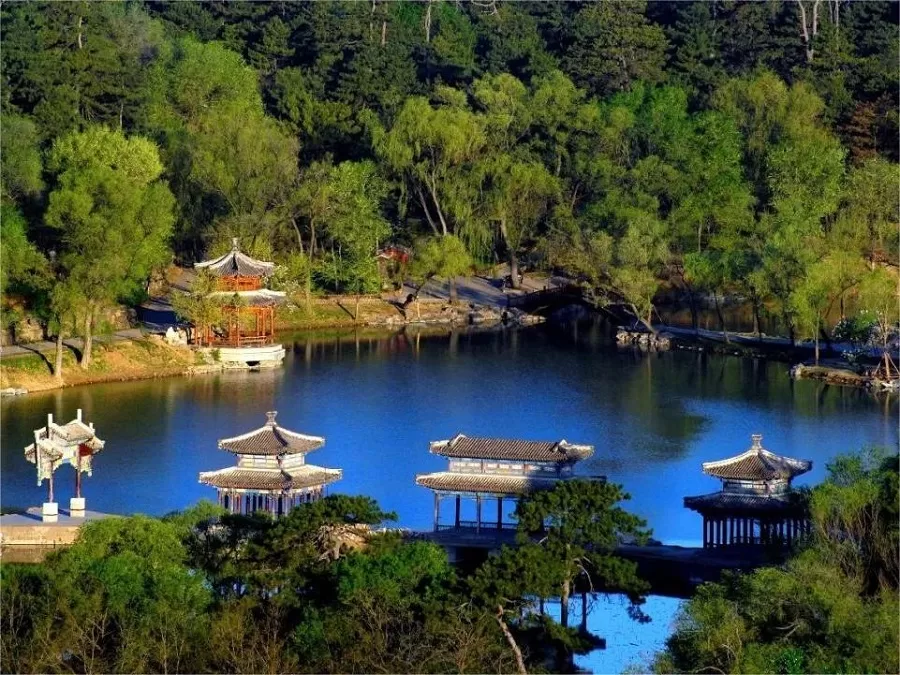Chengde Mountain Resort (承德避暑山庄), also known as Chengde Imperial Summer Resort or Rehe Imperial Palace, is a historic architectural complex located in Chengde, Hebei Province, China. Its construction began in 1703 and spanned the reigns of three Qing emperors: Kangxi, Yongzheng, and Qianlong. After 89 years of meticulous planning and construction, the resort emerged as a significant political and diplomatic center to deal with the relationship with minorities and foreign countries, second only to Beijing in the Qing Dynasty.
Covering an extensive area of 5.64 million square meters, Chengde Mountain Resort is divided into two main sections: the Palace Area and the Garden Area (comprising the Lake Area, Plain Area, and Mountain Area). What sets Chengde apart from other imperial gardens is its adherence to and development of the traditional Chinese garden philosophy, blending human-made beauty with natural landscapes. The resort harmoniously integrates ancient Chinese gardening and architectural arts with the natural terrain, creating a masterpiece that stands as a testament to the sophistication of Qing Dynasty design.
Table of Contents
- Basic Information
- Location and Transportation
- History of Chengde Mountain Resort
- Highlights of Chengde Mountain Resort
- Vlog about Chengde Mountain Resort
- Useful Tips Summarized from Reviews
- Attractions near Chengde Mountain Resort
Basic Information
| Website | http://www.bishushanzhuang.com.cn/ |
| Estimated Length of Tour | 3 – 4 hours |
| Ticket Price | 130 RMB (1st April – 31st October) 90 RMB (1st November – 31st March) |
| Opening Hours | 7.30 – 17.30 (1st April – 30th April) 7.00 – 18.00 (1st May – 9th October) 8.00 – 17.30 (10th October – 31st March) |
| Telephone Number | 0086-0314-2029771 0086-0314-2022779 |
Location and Transportation
The Chengde Mountain Resort is situated in Chengde City, within the Hebei Province of China. Chengde is approximately 230 kilometers northeast of Beijing, the country’s capital. This strategic location places the resort in the heart of a region known for its scenic beauty and historical significance.
Nestled at the foot of the Yanshan Mountains, the resort enjoys a temperate climate and stunning natural surroundings. The city’s proximity to the Great Wall of China further enhances its allure as a tourist destination. Chengde’s history is closely intertwined with the Qing Dynasty, and the Mountain Resort was specifically constructed as an imperial getaway from the summer heat for Qing emperors.
Tourists from other cities can first take a high-speed train to Chengde Railway Station and then transfer to a bus (No. 2, 5, or 15) or taxi to cover the remaining 3 kilometers.
History of Chengde Mountain Resort
The Chengde Mountain Resort, also known as the Imperial Summer Villa, has a rich history dating back to the Qing Dynasty. Its origins are intertwined with the establishment of the Mulan Hunting Grounds, created by the Qing government in 1681 during the 20th year of Emperor Kangxi’s reign. These grounds were intended to enhance the Qing Dynasty’s control over the Mongolian territories and solidify the northern defenses. Situated over 350 kilometers from Beijing on the Mongolian grasslands, the Mulan Hunting Grounds became the venue for the emperor’s annual autumn hunts. These hunts were grand events involving tens of thousands of people, including royalty, high-ranking officials, Eight Banner troops, and even concubines and other members of the imperial family. The hunts served dual purposes: military training and border security.
To accommodate the needs of the emperor and his entourage during these excursions, a series of 21 temporary palaces, known as xingong, were constructed along the route from Beijing to the Mulan Hunting Grounds. Among these, the Rehe Xingong, later known as the Chengde Mountain Resort, was a significant one.
The construction of the Chengde Mountain Resort can be divided into two major phases:
First Phase (1703-1713): During this period, Emperor Kangxi initiated the construction of the resort. The development primarily focused on creating the lake area, building islands, constructing dikes, and erecting palace buildings, pavilions, and walls. By the end of this phase, the resort had taken shape as a serene retreat. Emperor Kangxi named thirty-six scenic spots within the garden, each with a four-character title, highlighting the beauty and tranquility of the place.
Second Phase (1741-1754): Emperor Qianlong undertook extensive expansions of the resort during this phase. He added more palaces and numerous intricate, large-scale garden structures. Following in his grandfather’s footsteps, Qianlong named an additional thirty-six scenic spots, each with a three-character title. Together, these seventy-two scenic spots embodied the essence of the Chengde Mountain Resort. During this period, several temples were also constructed around the resort.
The Chengde Mountain Resort became an essential political and administrative center during the reigns of Emperors Kangxi and Qianlong. These emperors spent nearly half of each year in Chengde, conducting significant political, military, ethnic, and diplomatic affairs from this location. As a result, Chengde emerged as a secondary political hub, complementing Beijing.
Emperor Qianlong’s reign saw the resort host numerous notable events and dignitaries. Qianlong entertained prominent figures such as the Oirat Mongol leader, Tsering Dondup, the Torghut Mongol leader, Ubasi, and the 6th Panchen Lama of Tibet. The resort also welcomed the first British diplomatic mission to China, led by George Macartney, highlighting its importance as a center of international diplomacy.
However, the resort’s history was not without its darker moments. Emperors Jiaqing and Xianfeng both died at the resort. In 1860, during the Second Opium War, the resort served as a refuge for Emperor Xianfeng, who fled there to escape the Anglo-French forces attacking Beijing. It was within the safety of the Chengde Mountain Resort that he signed several unequal treaties, including the Treaty of Beijing with Russia. The political upheaval known as the Xinyou Coup, which significantly impacted Chinese history, also had its origins here.
As the Qing Dynasty declined, so did the resort. It fell into disrepair, mirroring the empire’s fortunes. Despite its faded glory, the Chengde Mountain Resort remains a testament to the grandeur and historical significance of the Qing Dynasty, attracting visitors who seek to explore its rich heritage and serene landscapes.
Highlights of Chengde Mountain Resort
Palace Area

The Palace Area, situated in the southern part of the resort, covers 102,000 square meters. It resembles a condensed version of the Forbidden City, featuring a meticulous layout of palatial buildings. Notable structures include the Main Palace, Songhezhai, Wanhu Songfeng, and Donggong. The Main Palace, consisting of nine courtyards divided into “Front Hall” and “Rear Quarters,” now serves as a museum displaying artifacts from the Qing Dynasty. Songhezhai, meaning “Pine Crane Longevity,” was built during the Qianlong era for the Empress Dowager’s residence. Wanhu Songfeng, serving as a transitional structure between the Palace and Lake areas, shares similarities with the Harmony Garden in the Summer Palace. Donggong, located at the easternmost part of the Palace Area, once hosted grand ceremonies and banquets but was destroyed during wartime.
Lake Area

The Lake Area, situated in the southeast of Chengde Mountain Resort, covers 496,000 square meters and features eight lakes collectively known as the Sai Lake. The scenic architecture in this area draws inspiration from famous Jiangnan landscapes, such as the “Yanyu Tower” modeled after the Yanyu Tower in Jiaxing, Zhejiang. Kangxi once praised Chengde Mountain Resort’s natural scenery as surpassing West Lake. Two islands in the lakes, namely Ruyizhou and Yuesejiangsheng, house various structures like pavilions, halls, and temples. Ruyizhou, with its clever layout, serves as the central focus of the scenic area.
Eight Outer Temples

The Eight Outer Temples of Chengde Mountain Resort form a captivating ensemble of Tibetan-style sanctuaries, embodying cultural diversity and spiritual significance. Scattered throughout the landscape, each temple boasts unique architectural features, intricate artwork, and a tranquil ambiance. These sacred structures pay homage to various Tibetan Buddhist traditions, serving as a testament to the Qing Dynasty’s embrace of cultural harmony. Visitors can explore a tapestry of temples, adorned with vibrant colors, ornate carvings, and serene courtyards, offering a spiritual journey and a glimpse into the fusion of artistic expression and religious devotion within the majestic backdrop of Chengde’s natural beauty.
Plain Area

Located in the northern part of the resort, east of the Lake Area, the Plain Area covers 607,000 square meters and consists mainly of grasslands and forests. Divided into the Western Grassland and Eastern Forest, the Western Grassland features the Shima Tai, where horse racing events were held. The Eastern Forest, known as Wanshu Park, was an essential political activity center. The area once had 28 Mongolian yurts of different sizes, including the largest one, Yumo Mongolian Yurt, with a diameter of 7 zhang 2 chi, serving as the emperor’s temporary palace for meetings with ethnic minority leaders, religious figures, and foreign envoys.
Imperial Living Spaces

The imperial living spaces within Chengde Mountain Resort unveil the opulent lifestyle of Qing emperors in a harmonious blend of architecture and nature. Palaces, halls, and pavilions, intricately adorned with vibrant colors and exquisite detailing, offer a glimpse into their refined tastes. These regal structures are thoughtfully integrated into the landscape, reflecting an appreciation for the serene surroundings. The living spaces, meticulously designed for comfort and grandeur, provide an insight into the Qing Dynasty’s splendor. Walking through these historical corridors allows visitors to step into a bygone era and immerse themselves in the lavish world of China’s imperial heritage.
Mountain Area

The Mountain Area, located in the northwest, covers a vast 4.435 million square meters, representing three-quarters of the entire garden. The topographical variation, ranging 180 meters from the northwest high peaks to the southeast lakes and plains, creates a picturesque landscape with peaks, valleys, and dense forests. The mountainous terrain acts as a natural barrier, protecting the resort from cold northwest winds and playing a crucial role in regulating the climate. Over 40 gardens and temples were strategically built in various locations, utilizing the natural features of peaks, cliffs, foothills, and streams.
Vlog about Chengde Mountain Resort
Useful Tips Summarized from Reviews
Sightseeing Shuttle and Stations: A sightseeing shuttle is available at 60 yuan per person. However, if the queue exceeds one hour, it is not recommended. The shuttle stops at three stations.
- The first, Sìmiàn Yúnshān (四面云山), offers a distant view of the old city area.
- The second, Èr Mǎ Dào (二马道), provides views of Putuo Zongcheng Temple and Xumi Fushou Temple, included in the resort ticket.
- The third, Qīng Fēng Lǜ Yǔ (清风绿屿), is a small courtyard known as the “Cold Palace” with views of Qingchui Peak and Liuhe Pagoda.
Commercial Street in Front: In front of the Mountain Resort, there is a commercial street. However, the taste of the food there is not particularly good.
Boat Tours and Stops: Boat tours on painted boats cost 70 yuan per person, stopping at Jinshan and Yanyu Tower. Although the boats are manually rowed throughout, the overall experience may not feel very valuable.
Evening Visits: Evening visits feature only lighting; there are no performances. Daytime exploration is recommended for a better overall experience.
Clean Restrooms: The restrooms at Chengde Mountain Resort are mentioned as the cleanest ones the reviewer has encountered in tourist areas.






